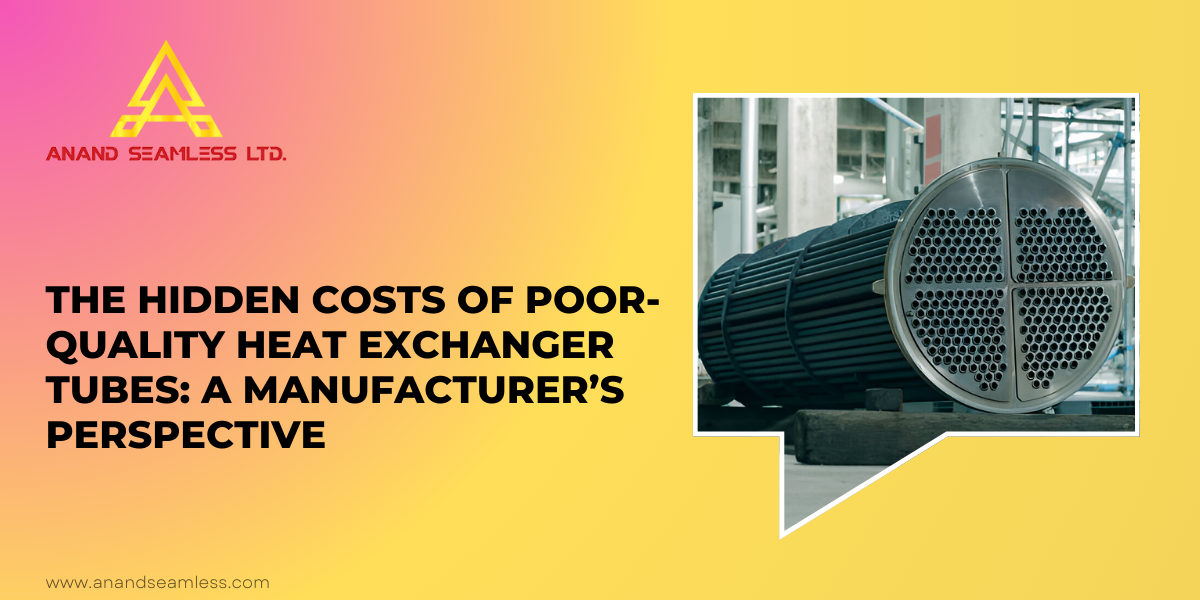Quick Inquiry
Heat exchangers play a critical role in various industries, including power generation, chemical processing, HVAC, and oil and gas. Their efficiency and longevity depend significantly on the quality of heat exchanger tubes. While businesses may be tempted to cut costs by opting for low-quality tubes, the long-term repercussions can be detrimental. From frequent maintenance to regulatory non-compliance, the hidden costs of poor-quality tubes can far outweigh the initial savings.
As a leading heat exchanger manufacturer in India, we aim to highlight the risks associated with subpar tubing and emphasise the importance of investing in high-quality solutions.

Common Defects in Low-Quality Tubes
Corrosion and Material Degradation
Inferior materials often lead to rapid corrosion and degradation. Heat exchanger tubes are exposed to high temperatures, aggressive chemicals, and varying pressure levels, making them susceptible to pitting, stress corrosion cracking, and oxidation. Poor-quality tubes may lack proper alloy compositions or protective coatings, accelerating their deterioration.
Manufacturing Inconsistencies (Thin Walls, Improper Welding)
Heat exchanger tubes require precise manufacturing to ensure uniform wall thickness and robust welding. Substandard production techniques result in thin walls, improper welding, and weak joints, leading to early failures and safety risks. These inconsistencies compromise structural integrity, making tubes prone to leaks and pressure-related breakdowns.
Contamination and Scaling Issues
Low-grade heat exchanger tubes are more susceptible to scaling and contamination, which significantly reduces heat transfer efficiency. Poor surface finishes and inferior material compositions encourage the accumulation of deposits, increasing thermal resistance and impairing performance.
How These Defects Lead to System Failures: Insights from a Leading Heat Exchanger Manufacturer
Reduced Thermal Efficiency and Heat Transfer Loss
The primary function of heat exchanger tubes is to facilitate efficient heat transfer. Any defects, such as corrosion, scaling, or inconsistent wall thickness, diminish the performance, leading to higher energy consumption and operational inefficiencies.
Increased Pressure Drops and Flow Restrictions
Manufacturing inconsistencies and scaling contribute to increased pressure drops, restricting fluid flow. This results in higher pumping costs and potential damage to other system components, further driving up operational expenses.
Unexpected Shutdowns and Maintenance Disruptions
Poor-quality heat exchanger tubes often fail unexpectedly, leading to unplanned downtime. These failures disrupt industrial operations, cause financial losses, and necessitate frequent maintenance interventions, affecting overall productivity. Investing in high-performance tubes from a trusted heat exchanger manufacturer helps prevent such disruptions and ensures long-term operational stability.
The Financial Impact of Poor-Quality Tubes
Frequent Tube Replacements
Low-quality tubes deteriorate faster, necessitating frequent replacements. This results in additional procurement costs and labour expenses, making them a costly choice in the long run.
Additional Expenses for Repairs and System Modifications
Industries using substandard heat exchanger tubes often find themselves making frequent repairs and system modifications to accommodate premature failures. These unexpected costs can quickly erode any initial savings from purchasing cheaper tubes.
Disruptions in Industrial Operations
Unexpected tube failures result in production slowdowns or complete shutdowns, affecting supply chain operations. Businesses relying on continuous processes suffer significant setbacks due to unreliable equipment.
Revenue Loss Due to Unplanned Shutdowns
Every hour of downtime translates into lost revenue. Unscheduled maintenance and repairs not only disrupt operations but also affect customer commitments and overall profitability.
Reduced Heat Transfer Efficiency Leading to Excessive Energy Use
When heat exchanger tubes fail to perform optimally due to defects or scaling, energy consumption rises. Poor thermal efficiency forces systems to work harder to achieve the desired heat exchange levels, leading to inflated energy bills.
Higher Operational Costs Over Time
Industries that overlook tube quality ultimately face higher operational costs due to inefficient energy usage, increased maintenance demands, and reduced equipment lifespan.
Safety and Compliance Risks
Pressure-Related Failures and Catastrophic Breakdowns
Substandard tubes may not withstand the pressure requirements of industrial applications. Tube failures can lead to explosions, leaks, and catastrophic equipment damage, posing severe risks to plant safety and operations. Choosing tubes from a reputable heat exchanger manufacturer is the key to meeting the necessary pressure tolerances and reliability standards.
Workplace Safety Hazards for Personnel
Defective heat exchanger tubes endanger plant personnel by increasing the risk of exposure to hazardous chemicals, steam leaks, and high-pressure failures. Ensuring worker safety should be a priority for any responsible business.
Non-Compliance with Industry Standards (ASME, ASTM, ISO)
The tubes must meet stringent industry standards such as ASME, ASTM, and ISO. Substandard products often fail to comply with these regulations, leading to regulatory issues and potential legal action.
Potential Fines, Legal Liabilities, and Reputational Damage
Non-compliance can result in heavy fines, legal liabilities, and reputational harm. Companies known for using low-quality materials may struggle to gain client trust and maintain long-term business relationships.
The Value of Investing in High-Quality Heat Exchanger Tubes
Durability and Extended Service Life
Premium heat exchanger tubes are designed for durability, ensuring extended service life and reducing the need for frequent replacements. This investment leads to significant cost savings over time.
Lower Total Cost of Ownership (TCO)
While high-quality tubes may have a higher upfront cost, their superior performance, longevity, and reduced maintenance requirements result in a lower total cost of ownership (TCO).
Enhanced Efficiency and Optimised Energy Use
High-quality tubes maximise thermal efficiency, reducing energy consumption and improving overall system performance.
Consistent and Reliable Industrial Operations
Reliability is crucial for industrial operations. Investing in superior tubes minimises disruptions, ensuring smooth and uninterrupted production processes.
Get Expert Advice Now!
How to Choose the Right Heat Exchanger Manufacturer
Key Factors to Consider: Material Selection, Certifications, and Testing Standards
When selecting a heat exchanger manufacturer in India, businesses should prioritise material quality, industry certifications, and adherence to rigorous testing standards. These factors ensure the longevity and performance of the tubes.
Importance of Working with Reputable Suppliers
Reputable manufacturers invest in quality assurance, R&D, and customer support. Partnering with a trusted supplier ensures access to premium products, technical expertise, and long-term reliability.
Evaluating Quality Assurance and After-Sales Support
Manufacturers committed to excellence provide comprehensive quality assurance measures, including rigorous testing protocols, material traceability, and after-sales support. Businesses should choose suppliers that offer warranties, technical assistance, and proactive maintenance recommendations.
Invest in Seamless Tubes for Reliable Heat Exchanger Performance
Poor-quality tubes can result in expensive maintenance, energy losses, and potential safety hazards. At Anand Seamless Limited, we provide high-quality seamless tubes designed for durability, efficiency, and compliance with industry standards. As a trusted heat exchanger manufacturer in India, we are committed to delivering reliable solutions that enhance your operational performance.
Contact us today at +91-9099996853 to find the best heat exchanger solutions tailored to your industrial needs.
lATEST BLOG |
|
U-Tube vs. Straight-Tube Heat Exchangers: Comparison Guide
Heat exchangers play a crucial role in industries |
|
Destructive vs. Non-Destructive Testing for Seamless Tubes
Seamless tubes play a critical role in industries |
|
The Hidden Costs of Poor-Quality Heat Exchanger Tubes: A Manufacturer’s Perspective
Heat exchangers play a critical role in various in |
|
Seamless Tubes in Boiler and Power Plants: Why They Are a Game-Changer
Seamless tubes are crucial in various industrial a |
|
Comparing Circular vs. Rectangular Finned Tubes: Which One Works Best?
In heat transfer applications, finned tube heat ex |

